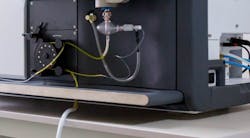Spectrometer Optics and Spectrometer Design
Spectrometer optics involves measuring light intensity by means of a specialized analytical tool called a spectrometer which separates light by wavelength. Spectrometers are used for a variety of applications, from studying special emission lines of distant galaxies to characterizing proteins in biochemical lens. They are used to detect cancer, for in breath analyzers, and to elucidate antibiotic resistance. The engineering team at Shanghai Optics is skilled in spectrometer design for research, industrial, medical and defense applications.
Basic Spectrometer Design
At its simplest, an optical spectrometer consists of an entrance slit, a diffraction grating or prism, and a detector. Routing optics are used to route the light within the spectrometer, from the entrance slit to the diffraction grating and on to the exit slit and detector. Filters are used in spectrometers that have a large range, to block higher orders of light from reaching the sensor and creating noise. The optical system separates light into its constituent wavelengths, producing a spectra, and the detector measures or displays the intensity of the light as a function of wavelength.
Single Beam Spectrophotometer Diagram
Every component of a spectrometer must be carefully engineered to reduce aberration, cut down on stray light, and achieve optimal resolution. Each application has its own requirements and its own specific balance of sensitivity and resolution requirements.
Types of spectrometer design include the Echelle configuration, the Czerny-Turner configuration, the Littrow configuration, the Ebert-Fastie configuration, and the concave aberration-corrected holographic grating configuration. The type of spectrometer you choose will depend on your application and what wavelength of light you wish to analyze, whether that is UV Vis or NIR. As the most commonly used configuration is the Czerny-Turner design, we’ll look at it in more detail here.
Czerny-Turner Spectrometer Design
This robust spectrometer design is based on two toroidal shaped mirrors (curved mirrors) which route light as required. Light enters the system through an entrance slit, then is collected by the first toroidal mirror and collimated. It travels from this initial mirror to the diffraction grating, then on to a second toroidal mirror which focuses the constituent wavelengths of light individually through the exit slit and onto a different position on the detector. A simple rotation of the grating can change the wavelength range projected onto the detector, and wavelength resolution can be changed either by changing the focal length of the system or by switching out gratings.
This spectrometer design is not symmetric, and the two mirrors do not have to be the same size, have the same radii of curvature or be located at the same distance from either the slits or diffraction grating. The extra parameters this introduces allow our engineers to design a system that works optimally for your application.
When the spectrometer is used to measure primarily one wavelength or even a wide range of wavelengths holographic gratings can be designed which produce a physical aberration that cancels out optical aberrations in the system. Since the Czerny-Turner configuration does not allow light to reflect directly from the entrance to exit, multiple dispersions and unwanted reflections are greatly decreased. This configuration also has the benefit of allowing for better coma correction than more symmetrical spectrometer designs.
Choosing the Specifications of Your Spectrometer Optics
Specifications of an optical spectrometer include wavelength range, optical resolution, slit size, sensitivity, timing and speed, and detector type.
The spectral ranges you are targeting will determine the grating size. For instance, a broadband grating (300 lines /mm) offers the greatest flexibility, but finer gratings (600 lines/mm, 1200 lines/mm, 2400 lines/mm or 3600 lines/mm) provide higher resolution and may be appropriate for narrower wavelength ranges. Our spectrometer engineers can give help you choose the best grating for your application.
Slit size is another parameter that effects resolution. Optimal resolution typically means a choice of the smallest slit size (10 microns), but sensitivity and throughput will decrease. To achieve the highest sensitivity and throughput, you may want to maximize your slit size. A light source with a large amount of excess light, however, would be an exception. If you anticipate the need to change slit sizes during the use of your spectrometer, you can order a slit kit which includes alternative slit sizes that can be switched in.
Sensitivity depends on slit size and high throughput, but also on a high quantum efficiency detector. This is especially important for fluorescence spectroscopy. Raman applications, on the other hand, require a more careful balance of resolution and sensitivity.
Speed is dependent both on the configuration of the spectrometer and the choice of detector. A linear detector array is speedier than a monochromator design, but high speed can also be achieved with a detector that supports high speed data acquisition.
Spectrometer Optics at Shanghai Optics
Manufacturing high performance spectrometers requires highly sophisticated production devices, state of the art metrology, and a careful quality control process. At Shanghai Optics, we meet all these requirements and more. More than 60 years in the industry has given us a unique understanding of the properties of light and a unique ability to craft high precision optical instruments. Our state of the art metrology equipment allows us to ensure every mirror, grating, and optical component used in our assemblies meet and exceed all relevant standards.
We stand behind each of our products, and can provide detailed specs for each of our components. For each spectrometer detector, we have quantified dark noise, signal to noise, photo response non-uniformity, and hot pixels. A large line-up of in-stock components enables the speedy assembly of many spectrometer configurations, and if you require something that is not yet available we would be happy to make it just for you. Please contact us to discuss your use case and requirements or to schedule a free consult.
